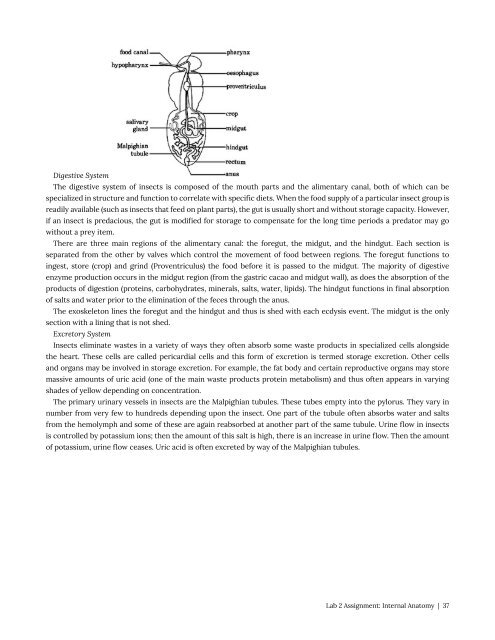Entomology 311 Lab Manual - 1st Edition, 2019
Entomology 311 Lab Manual - 1st Edition, 2019
Entomology 311 Lab Manual - 1st Edition, 2019
Create successful ePaper yourself
Turn your PDF publications into a flip-book with our unique Google optimized e-Paper software.
Digestive System<br />
The digestive system of insects is composed of the mouth parts and the alimentary canal, both of which can be<br />
specialized in structure and function to correlate with specific diets. When the food supply of a particular insect group is<br />
readily available (such as insects that feed on plant parts), the gut is usually short and without storage capacity. However,<br />
if an insect is predacious, the gut is modified for storage to compensate for the long time periods a predator may go<br />
without a prey item.<br />
There are three main regions of the alimentary canal: the foregut, the midgut, and the hindgut. Each section is<br />
separated from the other by valves which control the movement of food between regions. The foregut functions to<br />
ingest, store (crop) and grind (Proventriculus) the food before it is passed to the midgut. The majority of digestive<br />
enzyme production occurs in the midgut region (from the gastric cacao and midgut wall), as does the absorption of the<br />
products of digestion (proteins, carbohydrates, minerals, salts, water, lipids). The hindgut functions in final absorption<br />
of salts and water prior to the elimination of the feces through the anus.<br />
The exoskeleton lines the foregut and the hindgut and thus is shed with each ecdysis event. The midgut is the only<br />
section with a lining that is not shed.<br />
Excretory System<br />
Insects eliminate wastes in a variety of ways they often absorb some waste products in specialized cells alongside<br />
the heart. These cells are called pericardial cells and this form of excretion is termed storage excretion. Other cells<br />
and organs may be involved in storage excretion. For example, the fat body and certain reproductive organs may store<br />
massive amounts of uric acid (one of the main waste products protein metabolism) and thus often appears in varying<br />
shades of yellow depending on concentration.<br />
The primary urinary vessels in insects are the Malpighian tubules. These tubes empty into the pylorus. They vary in<br />
number from very few to hundreds depending upon the insect. One part of the tubule often absorbs water and salts<br />
from the hemolymph and some of these are again reabsorbed at another part of the same tubule. Urine flow in insects<br />
is controlled by potassium ions; then the amount of this salt is high, there is an increase in urine flow. Then the amount<br />
of potassium, urine flow ceases. Uric acid is often excreted by way of the Malpighian tubules.<br />
<strong>Lab</strong> 2 Assignment: Internal Anatomy | 37


















